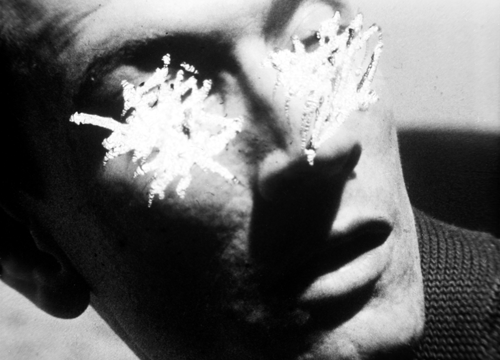How many colors are there in a field of grass to the crawling baby unaware of ‘Green’? How many rainbows can light create for the untutored eye? – Stan Brakhage in a great opening to a manifesto (Metaphors on Vision), lousy prelude to a discussion of a black-and-white short.
Reflections on Black (1955) dir. Stan Brakhage
I was in film school when Stan Brakhage died in 2003. My professor paid homage to him at the start of a production class by recounting the parable of the blind men describing an elephant. Each man put a hand on the elephant and described the elephant accordingly. The man who felt the trunk compared the elephant to a snake, the man who felt the ear likened it to a fan, the leg conjured a tree-like creature, and so on. Each man described the elephant according to their own perspective. “Brakhage,” my professor told us, “touched parts of the elephant few dared to touch.”
Movies have always been shackled to one language or another. Written and later spoken language, of course, with all its baggage and interpretations. But also body language, the language of theater, the expectations of narrative, etc. Kansas City-born Stan Brakhage forged a path in experimentation by expressing ideas and emotion with the medium itself and was one of the first filmmakers to draw attention to the medium of film. Not just to the craft of making a film, but to the potential for expression in an actual piece of celluloid, communicating with film manipulation the way Pollock communicates with a paint splatter. While my professor’s attempt at analogy speaks to the ballsy nature of Brakhage’s work, it would be more accurate to say Brakhage sought to describe the elephant not by comparing its nature to other animals and objects, but by imprinting peoples’ palms with elephantness.
1955 demonstrates a turning point for Brakhage. “Reflections on Black,” made before Brakhage’s rise to notoriety in the early 60s, contains nascent elements of his later approach. Namely, the blind man’s eyes have been scratched off the frames by hand. Film scratches would appear through the rest of Brakhage’s life (his final film was a series of scratches he made on 35mm leader with his fingernails – the film ended when he did). A POV shot near the end of “Reflections” – the scratches now full-frame, filling the viewer’s “eyes” – is especially evocative of things to come as it foreshadows later films where the closest thing to a protagonist is the medium itself.
Other than those scratches, “Reflections” plays a lot more like a more standard surrealist film, with a reliance on actor performances and blocking. But later that year Brakhage would receive a commission to film a closed section of the New York City elevated train before its demolition. The result announced the Brakhage to be. As Brian Fyre described for Senses of Cinema:
Working for the first time without actors or plot, Brakhage began to focus on the expressive qualities of the medium itself. The film […] represents Brakhage’s first step toward his radical reconception of the cinema. There is no story, no protagonist, no linear narrative other than the train itself, traveling endlessly along its track. It is a perfect expression of the world defined by the train, and a peculiarly apposite metaphor for the bare logic of narrative itself.
“The Wonder Ring” not only eschews story and performers, but sound as well (it’s not a problem with your speakers). This was a feature of many of Brakhage’s films after this. Same with overlapping images and the phenomenons of light refraction through textured glass.
Imagine the usual approach to documenting the final laps of an El train in a mid-20th century film. There would be voiceover describing what we’re seeing on the screen. There might be a narrative foisted onto the images (“Here’s little Timmy on his visit to the Third Street platform. Don’t let that beatnik talk you out of your ticket, Timmy!”) and maybe reactions by actors for us to mirror (“Jeepers, that’s a fast train!”). Even a less corny example would at least show a wide shot of a train approaching on the tracks, cut to an insert of the wheels, cut to passengers as they board, etc. We’d get a lot of information about the process of riding a train, which we could also get from a brochure. We’d get an objective view of what a train looks like and how it moves, which was already accomplished by literally one of the first motion pictures ever made.
Using a camera to describe a train as a series of motions and a spray of images takes advantage of the unique abilities of motion pictures without overlapping the strengths of other mediums. A burst of light through a window made crooked by horizontal speed perceives and relates something about the nature of a train that a photo, novel, or painting does not. After all, why touch the same part of the elephant?
- For a superior essay about where Brakhage would go from here, look no further than wallflower’s piece on this very site.
- While rewatching “The Wonder Ring,” I caught a glimpse of the shots of passing platforms reflected in a laminated photo on my wall, adding another layer of reflection and image. It was quite beautiful, and it also reminded me of a discussion on this article about how important the method of experiencing a Brakhage film.

